Groudle Glen Railway
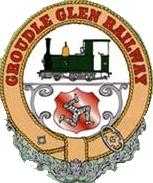 | |
| Official Crest of the railway | |
| Locale |
|
| Terminus | Lhen Coan and Sea Lion Rocks |
| Coordinates | 54°06′14″N 4°15′07″W / 54.1039°N 4.2519°WCoordinates: 54°06′14″N 4°15′07″W / 54.1039°N 4.2519°W |
| Commercial operations | |
| Name | Groudle Glen Railway |
| Preserved operations | |
| Stations | 2 and 1 halts |
| Commercial history | |
| Opened | 1895 |
| Closed | 1962 |
| Preservation history | |
| 1982 | Restoration commences |
| 1983 | Short section opens for Santa Train |
| 1986 | Official re-opening |
| 1987 | Sea Lion returns |
| 2007 | 25 Years since the re-opening |
| 2013 | Brown Bear appeal launched |
The Groudle Glen Railway is a narrow gauge railway north of Douglas in the Isle of Man which is owned and operated by a small group of enthusiastic volunteers and operates on summer Sundays; May to September and Wednesday evenings in July and August along with a number of annual special events.
History
.jpg)
- 1896 – 1939
The line was built in the late Victorian era in response to increasing demand for transportation down Groudle Glen brought on by the introduction of the Manx Electric Railway. The headland was developed, with a zoo being created and the railway being built. The 2 ft (610 mm) gauge line ran from the upper part of the glen, Lhen Coan, to the Zoo at Sea Lion Rocks. The line opened on 23 May 1896 and started with one engine, called Sea Lion, and three coaches. The engine was built by W.G. Bagnall Ltd. of Castle Engine Works, Stafford. The line became so popular that a further engine, Polar Bear, and additional coach stock was purchased. The railway operated very successfully until the outbreak of the First World War when all services ceased and the associated zoo was closed. When the line re-opened the locomotives were overhauled and returned to service but by 1921 they had been replaced with battery-operated engines. These proved troublesome and after proving inefficient and costly, they were dropped, the original steam locomotives being overhauled and returned to service. The railway once again closed during the Second World War and the zoo closed for good, it being reported that the animals had been released! A landslide during the war years ensured that services could not return to the original terminus.
- 1950 – 1981
The line took some time to re-open after the war, the draw of the zoo being lost meaning the glen itself was less frequently visited. Only one locomotive returned, for the 1950 season but over the next twelve years the seasons were somewhat sporadic and no timetable was officially issued. 1962 proved the final season, with "Polar Bear" refusing to hold a head of steam. The final two seasons were known as the "fairground era" as the stock was all painted in loud colours with blue and red dominating, and fairground-style lettering and lining applied to the locomotive. By the late 1960s the engines had been removed from the glen and Polar Bear was restored as an operating exhibit at Amberley Working Museum, West Sussex and Sea Lion was taken to Loughborough where it remained until 1987 when it was finally restored and returned to service on the restored line. The railway became a footpath, only to be disturbed by the occasional walker. It seemed that this unique piece of Manx heritage was lost. Much of the railway's infrastructure was lost at this time, the distinctive station canopy being demolished in 1979 and the remaining smaller buildings lost also.
- 1982 – 1991
In 1982, the Isle of Man Steam Railway Supporters' Association launched a plan to restore the line and work began clearing twenty years worth of undergrowth that had reclaimed the trackbed. In time for December 1983 a short section from the old lime kiln to the headland had been re-built and the railway commenced its Santa Train operation, now an established part of the island's social calendar. Little by little the line was relaid to the glen terminus of Lhen Coan and a station was created at the headland with run-round facilities. The railway was officially re-opened on 23 May 1986 by Carolyn Rawson as part of the Manx Heritage Year and a tree planted to mark the event in Lhen Coan station. The most significant event at this time was the return of the original steam locomotive "Sea Lion" in September 1987, which was much heralded in the local press. By 1991 the decision had been made to excavate the final section of the line from the headland loop to the former terminus at Sea Lion Rocks and the run-round loop was lifted at the end of the 1991 season when the major earthworks began to relay the original section to the outer terminus.
- 1992 – 2002
The extension, recreating the line to its original three quarter-mile length was duly opened on 23 July 1992, and this was followed in 1993 with the opening of the distinctive Swiss-style station canopy at Lhen Coan, a feature of so many postcards of the glen, as part of the Year of Railways celebration. It was during this year that "Polar Bear" also returned to the glen for a visit. It was a time of great change for the line, with many improvements being introduced by the volunteers. Visiting locomotives were a feature in 1995 (Chaloner and Rishra) and in 1998 as part of the Steam 125 event marking the anniversary of the island's main railway. Planning permission was granted in 1999 for the volunteers to erect a replacement station building at Sea Lion Rocks and by the summer of 2000 work was well in hand. The station building opened the following year but it was in 2003 that the interior of the station was completed and since this time it has proved to be the major draw to the railway, aside from the unique steam locomotives. The station and surrounding area have since received much attention as ongoing projects and the development of the site has also revived interest in the amazing zoo that once drew in the crowds, the remains of which are still viewable from the station site.
- 2003 – 2009
The addition of a replica battery electric locomotive in 2003 completed the line's historical line-up of locomotives and a return visit from Polar Bear for her own centenary in 2005 was repaid by Sea Lion making her first trip to Amberley Museum in the same year. Back on the railway, in 2007 a new purpose-built locomotive shed was erected on the site of the original, but to a larger scale, and a mess hut was installed making the station at Lhen Coan a transformed area, in keeping with the original site. In September 2007 the railway marked the twenty-fifth anniversary of restoration by unveiling a plaque at Lhen Coan station. This event also marked the official opening by Annie Craine MHK of the railway's new purpose built locomotive shed. Plans were well in hand to rebuild the souvenir shop at Lhen Coan in a style similar to the distinctive station canopy and the close of the 2008 season saw the previous incarnation dismantled in readiness for the erection of the new, pre-fabricated version on the same site. A mock signal box was also completed to cover the side of the volunteers' mess room in this year also, and by December work was in hand to close the shop for good after the Santa Trains. The new shop opened fully for Easter 2010 and now dominates the station site.
- 2010 –
In 2010 an appeal was launched to raise the £60,000 required to extend the Sea Lion Rocks Tea Rooms to provide toilet facilities, a power supply and improved patio area, this was completed in time for the Easter 2012 services, and was re-opened by Allan Bell MHK, the Island's Chief Minister, in May 2012 to mark the 30th Anniversary of the railway's restoration. During the 2012 season planning permission was granted to enlarge the platform area at Lhen Coan station and construct a new utility building to replace the time expired tea hut, which was demolished after Christmas 2011. Construction work started in September, funded by the Manx Lottery Trust and Tower Insurance, and required the railway to transport 140 tons of rock to the site, for the platform extension foundations and infill. New stone faced walls to link the 2007 engine shed to the existing 1896 dry stone wall were also part of the project. The building was constructed by volunteer joiner Stephen Goody to match the style of the canopy, shop and booking office, and the entire area was completed in time for the Christmas services.
Stations
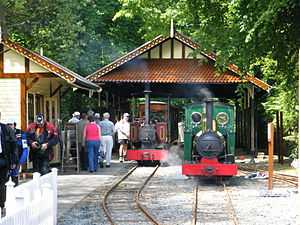
| Groudle Glen Railway | |||||||||||||||||||||||||||||||||||||
|---|---|---|---|---|---|---|---|---|---|---|---|---|---|---|---|---|---|---|---|---|---|---|---|---|---|---|---|---|---|---|---|---|---|---|---|---|---|
Legend
| |||||||||||||||||||||||||||||||||||||
Despite being under one mile long, the railway does have intermediate stations, although only one of them is still operational for passengers and the other forms the site of the current passing loop when two trains are in operation (this was extended in 2011 to allow trains with more coaches to pass each other unhindered); the outer terminus is home to the visitor centre whilst the inner station houses all the running sheds and the railway's workshops.
- Lhen Coan Station, the lower terminus where all the rolling stock is housed
- Lime Kiln Halt, the only intermediate halt on the railway, the halfway point
- Headland Station, now closed, one-time terminus of the line prior to 1991
- Sea Lion Rocks, outer terminus on the cliffs above the old zoo
Each of the railway's stations is now colour-coded, with all station furniture, waiting shelters, etc., in a corresponding scheme. The terminus at Lhen Coan is in brown and cream (similar to Great Western Railway stations), with Lime Kiln Halt in a green scheme (similar to the Southern Railway) and Sea Lion Rocks in a bright shade of red/maroon. In the past each station was decorated in a house style of deep brown and cream throughout the period 1991-2000, changing to individual station colour schemes thereafter, although individual shades used have varied since this time.
Operations
Seasonal
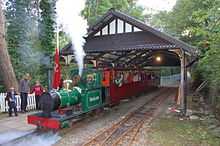
When it originally opened in 1896 the line ran a very intense all-day every-day service in season. A fourth coach was ordered within the first year to cope with demand, followed by a further locomotive and four coaches eight years later. Today is a different story, the railway operates to a set timetable annually with trains running every Sunday between May and September, with the first train at 11:00 am and final departure at 4:30 pm; in addition to this evening services operate between 7:00 pm and 9:00 pm on Wednesdays in July and August, and Tuesdays in August only. One of the resident steam locomotives is in service wherever possible for each of the advertised operating days. When the line first re-opened services were also provided on bank holidays and public holidays but this practice has been discontinued in more recent years. As part of the involvement with the Year Of Railways in 1993 and subsequent anniversaries, the line has operated daily for periods of up to one week, the last being as part of Steam 125 in 1998 when visiting locomotives were in attendance. The railway's current standard timetable can be found at its website including details of special services.
Christmas
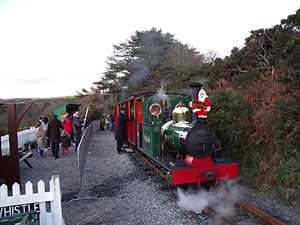
The first services ever operated on the newly restored railway were the Santa Trains in 1983 which have since proved to the be highlight of the line's calendar; they began life as one day of operation the weekend before Christmas Day but today these extend to two weekends of trains, which are the railway's busiest period of year, culminating in the popular Mince Pie Trains which are a regular fixture each Boxing Day when many locals visit the line for a return journey and a seasonal drink and mince pie. The station at Lhen Coan is transformed into a grotto area for these services and the volunteers spend many hours preparing the site for the festive services, and one of the railway's two diesel locomotives is renamed as "Blizten" for the day, originally the traditional name of "Rudolph" was applied but this was changed in 1997 following requests. Such is the continued success of these seasonal services that the railway introduced online pre-booking in 2010 for the first time, and now operate them over three days; the original operation was only for one day each December.
Easter
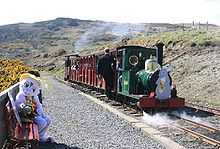
Since the restoration of the railway began the line has always opened for the Easter weekend but the bunny trains only commenced in 1997 and were introduced following a request for them from the Isle of Man Hospice Care which has close ties with the railway, the train services being provided free of charge. However, following the success of the venture, the next year the railway embarked on its own enterprise and provided the bunny express trains for their own profit and they became an immediate success, with the full line being utilised (rather than the glen section which is used at Christmas). In addition to the two steam locomotive being in operation providing a top-and-tail train service (this ensures speedy turnaround and removes the necessity for locomotives to run round their trains at either end of the line), the Easter Bunny is on hand to distribute chocolate eggs at the outer terminus, second only to the Santa Trains these services which operate on Easter Sunday and Monday are the line's busiest and provide a bump start to each summer season.
Jester Express
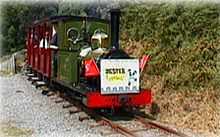
As part of the railway's fundraising drive for a new station building at Sea Lion Rocks terminus some special event days were run at weekends in either July or August, during the school summer holidays, for three years from 2000 to 2002. The outer terminus of the line at Sea Lion Rocks was transformed into an Arthurian themed area for the day, with two volunteers (acting as train guards) dressed as jesters, much to the amusement of the children, and a bouncy castle presided over by Merlin, and King Arthur in attendance to greet children; a set of stocks were the biggest draw for the children however, and these trains were very popular with local residents, with associated stalls, raffles and light refreshments being made available. A shortage of volunteer labour in subsequent years resulted in this innovative family day being dropped from the railway's calendar, but the event returned for the 2010 Season and now forms an integral part of the line's annual calendar of special events.
Other Events
As part of a new drive to attract more local visitors to the line and to recruit new volunteers to run the line, a wide programme of special events were introduced for the 2010 season. Alongside the annual Easter Bunny Trains and Santa Specials, the Jester Express Fun Day returned in July, alongside the new Diesel & Electric Day in May, the Father's Day Trains in June and the Teddy Bear's Picnic in August. The Teddy Bear's Picnic wasn't repeated due to competition from the Government railways own event not making it financially viable. Another new initiative for 2010 was the introduction of Driver Experience sessions, bookable by the railway's website, a 2 hour session on the footplate of locomotive Annie is offered as a hands on experience. Despite the level interest shown in the driver experiences, it was proving prohibitively costly and the sessions aren't to be repeated in 2013. A new special event for 2011 was the summer Cliff Top Concerts, supported by the Isle of Man Arts Council. A day of free open air concerts from Manx groups and musicians were performed at Sea Lion Rocks, this event was deemed a great success and has been repeated every year since. The 2013 season sees further development of the Special Events calendar with new events planned such as the Wag 'n' Train with the Manx S.P.C.A., outdoor Church Services by the Sea and the Biggest Bake Off with the Women's Institute.
Rolling Stock
Locomotives


The original steam locomotive remains in regular traffic and is supplemented by a further replica locomotive, two diesel locomotives and a replica battery electric vehicle. In addition to this a further diesel locomotive owned by one of the volunteers is in store on the line with a view to possible restoration and entry into traffic. In the past there have been further locomotives, most notably a sister to Sea Lion, two original battery electric locomotives and several visitors.
- Sea Lion (1896) the line's original locomotive.
- Polar Bear (1905) The line's 2nd locomotive. Now resident at the Amberley Museum Railway but has returned for visits in 1993, 1996 and 2005.
- Brown Bear (2013/4) Project announced in January 2013. New build replica of Polar Bear of 1905.
- Annie (1998) A replica of a loco supplied to the Gentle Annie Tramway in New Zealand, chosen because of the mechanical similarity to Polar Bear.
- Dolphin (1952) second-hand diesel locomotive purchased in 1983 for use
- Walrus (1952) second-hand diesel locomotive purchased in 1983 for use
- Sea Lion (1921) original battery powered locomotive, scrapped 1923
- Sea Lion (Replica) (TBA) of original battery powered locomotive, resident at the Amberley Museum Railway.
- Polar Bear (Replica) (2003) of the original locomotive, in service
- Polar Bear (1921) second original battery locomotive, scrapped 1926
- Parracombe (1947) current railway resident, used on one day after purchase before being withdrawn for restoration which is currently ongoing
Since restoration a number of visiting locomotives have operated on the line; following Kerr Stuart Peter Pan in 1991, there were Rishra and Chaloner from the Leighton Buzzard Narrow Gauge Railway in 1995 as part of the International Railway Festival in conjunction with the centenary of the Snaefell Mountain Railway, followed by Quarry Hunslet locomotive Jonathan in 1998. Subsequent returns by Chaloner have also been made, and the line's other original locomotive, Polar Bear, has returned in 1993 as part of the Year of Railways, in 1996 for the railway's centenary and again in 2005 for her own 100th birthday. Since being sold, Jack has also made one return visit in 1999, and future visits for other locomotives are being planned.
- Chaloner (1877) visited the line in 1995 and 1999 from the mainland
- Jack (1925) lived on the railway between 1992 and 1996, now off-island
- Rishra (1921) visited the line in 1995 from the mainland
- Jonathan (1878) visited the line in 1998 as part of Steam 125
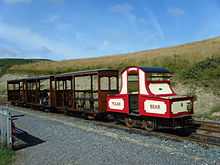
Carriages
The railway originally had a total of eight four-wheeled coaches delivered in three batches; three were delivered in 1896 for the opening of the railway followed by one more shortly thereafter to cope with passenger demand, and a further batch of four arrived in 1905 with the second locomotive. Several parts of these vehicles were saved from the site after closure resulting in ultimate restoration of many of the coaches both on the railway and off-island. The restored railway now operates with four of these four-wheeled toastrack coaches in addition to the set of three bogie coaches that were built between 1985 and 1994 by the railway's volunteers based upon second hand underframes they had purchased, with a further underframe functioning as a runner in the early years of operations.
Non-passenger stock
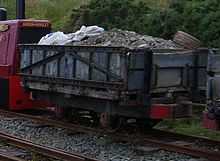
Originally, as the railway was built entirely as a pleasure line, being manually constructed with no use of rail wagons, there were no non-passenger vehicles supplied to the railway but it is known that latterly, at least one of the original four-wheeled toastrack-type coaches had its bodywork removed and was used as a runner, supplying stock for the Headland Cafe below the line's later terminus. When the restoration began the volunteers required permanent way rolling stock to further the rebuild and so purchased a set of six "bomb" wagons from the R.A.F. base at Fauld near Uxotter, but of these only five have seen service on the line and until recently all have remained on site, out of use in poor condition. In 2011 all of the remaining wagons were deemed beyond repair and scrapped, with the wheelsets retained. In 2012 two wheelsets have been incorporated into a new-build tank wagon which is to be used in conjunction with the new toilet facilities at Sea Lion Rocks.
Modern Stock
The initial basis of freight stock has been supplemented in recent years by a series of flatbed runners (both four-wheelers and longer bogie stock), a large second hand four-wheeled brake van and a tipper wagon, the latter not being used in regular operation. As part of the Steam 125 railway celebrations that took place in 1998 the railway played host to its most unusual visitor, a hand made rail bike from Dr Karl Pischl in Austria. This unusual home-made vehicle was effectively a four-wheeled bicycle on flanged wheels. To replace a variety of four-wheel wagons that were time-expired, a new bogie works van was delivered to the line in 2011 for use by permanent way crews. This features an open wagon and covered accommodation area.
See also
- Isle of Man Steam Railway Supporters' Association
- Manx Electric Railway stations
- British narrow gauge railways
References
- Beard, Tony (1994). Groudle Glen Railway: Its History & Restoration. Groudle Glen Railway.
- Smith, David Hyland (1989). The Groudle Glen Railway. Brighton: Plateway Press. ISBN 1871980003.
- Manx Steam Railway News (Isle of Man Steam Railway Supporters' Association). 1966–.
External links
| Wikimedia Commons has media related to Groudle Glen Railway. |
- Groudle Glen Railway – official site
- IOM Guide – Groudle Glen Railway
| ||||||||